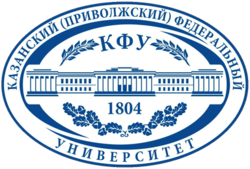Kazan (Volga region) Federal University
| Kazan (Volga region) Federal University | |
|---|---|
| Казанский (Приволжский) федеральный университет | |
|
Logo of the university | |
| Established | 5 (new style: 17) November 1804 |
| Type | Public |
| Rector | Il'shat Ghafurov |
Administrative staff | ~3,500 |
| Students | ~50,000 |
| Location |
Kazan, Russia 55°47′27″N 49°07′19″E / 55.7907°N 49.1219°ECoordinates: 55°47′27″N 49°07′19″E / 55.7907°N 49.1219°E |
| Campus | Both urban and suburban |
| Website | eng.kpfu.ru |
Kazan (Volga region) Federal University (Russian: Казанский (Приволжский) федеральный университет; Tatar Cyrillic: Казан (Идел Буе) федераль университеты, Latin: Qazan federal universitetı) is located in Kazan, Tatarstan, Russia. It was established in 2010 on the basis of the former Kazan State University, originally founded in 1804 as Kazan Imperial University.
Kazan University is the second oldest of the current Russian universities. The famous mathematician Nikolai Ivanovich Lobachevsky was its rector from 1827 until 1846. In 1925, the university was renamed in honour of its most famous alumnus, Vladimir Ilyich Ulyanov (Lenin). Kazan University is known as "the birthplace of organic chemistry" due to works of Aleksandr Butlerov, Vladimir Markovnikov, Aleksandr Arbuzov, and the birthplace of Electron Spin Resonance due to work of Evgeny Zavoisky.
Kazan's oldest part of the university building contains three classical portals along its white facade from the original 1822 construction. Included with this building is the First Boys' Gymnasium and the private residence of Prince Tenichev that was given to the university at the time of its founding. From 1832 through 1841, architect M. Korinfsky constructed the rest of the buildings. These included the Anatomy Theatre, the Library, the Chemistry and Physics Laboratories and the Observatory, completed the University complex and gave it its neo-classical look. The building of the Chemistry Faculty was constructed in 1954 by the students themselves.
On October 21, 2009, Russian President Dmitry Medvedev signed an executive order that would establish a new Volga Federal University on the basis of Kazan State University.[1][2] The federal university project was realized in early 2010 on the basis of Kazan State University, with the accession of the Tatar State University of Humanities and Education (TGGPU) and the Kazan State Finance and Economics Institute (KGFEI).[3] The university's first rector is Ilshat Rafkatovich Gafurov, formerly the mayor of Elabuga.[4][5] The current president is Myakzyum Salakhov.
History
The Kazan State University is one of the oldest universities in Russia. It was founded the 5th (New Style 17) of November 1804, when the Emperor Alexander I signed the Charter about the creation of the Kazan Imperial University.
Already during the first decades of its existence, it became one of the major centers of education and science. This institution formed a big number of scientific areas and schools (mathematical, chemical, medical, linguistic, geological, geobotanical, etc.). It is subject of special pride: the creation of non-Euclidean geometry (Nikolai Lobachevsky), the discovery of the chemical element ruthenium (Claus), the theory about the structure of organic compounds (Aleksandr Butlerov), the discovery of the electron paramagnetic resonance (Yevgeny Zavoisky) and acoustic paramagnetic resonance (Altshuler) and many others.
Since its inception, the university has trained more than 70 thousand professionals. Among university students are outstanding scholars, as well as representatives of culture, public figures: Aksakov, Mily Balakirev, PI Melnikov-Pechersky, Michael Minsky, Leo Tolstoy, VI Ulyanov Lenin, Vladimir Khlebnikov, NA Busch, VF Zaleski.
In 1925 the Kazan State University was renamed to the V. I. Ulyanov-Lenin Kazan State University, by decision of Presidium of the All-Russian Central Executive Committee (VTsIK) dated by 25 June 1925.[6]

Imperial period
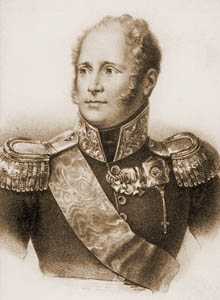
On 5th (17th) November 1804 Emperor Alexander I signed a charter establishing a new university in the city of Kazan. The first students (of February 1805) became graduates of the First Kazan Gymnasium - an autonomous affiliate of the Moscow State University, under whose auspices the Kazan University first operated.
It was not until 1814 that the university underwent its full opening, that is to say that it was restructured as a classical university comprising four departments: moral and political sciences, physical and mathematical sciences, medical sciences and philology. Before the founding of the University of Kazan, Tomsk was the easternmost university in the Russian Empire, it was thus responsible for the vast regions of the Volga, Kama, Ural, Siberia and the Caucasus - a responsibility ultimately ceded to the University of Kazan. It is interesting to note that in the first decades of its existence, the University of Kazan became Russia's leading centre for the study of Oriental languages .
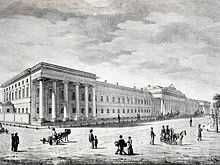
In 1819, M. L. Magnitsky conducted a review of the university in which he reported on 'the spirit of dissent and irreligion' that he had found at the university. In his report to the emperor, he spoke of the public failure of the university and demanded it be closed, but Alexander I put the resolved 'why destroy what can be corrected'. Magnitsky was consequently appointed trustee of the Kazan school district, an action that negatively affected the university, with many professors being dismissed and 'harmful' books withdrawn from the library's collection. What is more, a strict barrack-style domestic regime was introduced for students of the university.
In 1825, the main building of the university was built and, in 1830, the main campus was completed. This included the library building, chemical laboratory, dissection facilities, astronomical observatory, clinics (in the organisation of the which contemporaries noted the leading role of Professor FO Yellachicha) and other such buildings. Resultantly the university became a leading centre of education and in the sciences. It was the scientific faculties that were, at this time, organised into a number of scientific areas and schools: mathematical, chemical, medical, geological, and other geobotanic. Just four years later, in 1834, the journal 'Proceedings of the University of Kazan' began to be published by academics at the university and in 1825 the charter of Nicholas I, established the university's three faculties: the philosophical faculty (which was further subdivided into verbal and physical-mathematical departments), legal faculty and medical faculty.
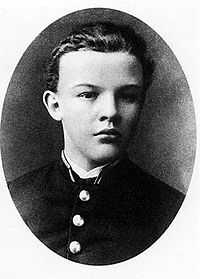
In 1844, Karl Klaus, a professor at the university, discovered, and named in honour of Russia, Ruthenium, the only chemical element discovered in Tsarist Russia. Six years thereafter, and in connection with the establishment of the Eastern Department of the St. Petersburg University's Oriental Institute, all training materials and the collection of the University of Kazan in the field of Oriental Studies were transferred to the capital. Shortly after that, there was a further reform of the university's structure, when in 1863, by order of Alexander II, the university was reorganised into four departments: History and Philology, Physics and Mathematics, Law, and Medicine. A renowned linguistic school operated at the university in the years 1875-1883.
Notably, between August 1887 and his expulsion in December 1887 for 'student disturbances',[7] Vladimir Ilyich Ulyanov (Lenin), future leader of the Soviet Union, studied law at the university.
The university faced one of its greatest challenges yet during the Russian Civil War when in August–September 1918 the siege and ultimate capture of Kazan by the Red Army and Czechoslovak Corps led to a large exodus of both residents and students and faculty members from the city. Subsequently many of Kazan's escaping students and academics were enrolled in state universities in Siberia, where the help they provided proved instrumental in the foundation of universities in Tomsk and Irkutsk.
Soviet period
In accordance with the SovNarKom directive of 9 October 1918, the system of academic ranks was abolished and all university-level pedagogues with at least three years teaching experience were afforded the title of professor. This allowed the University of Kazan, which had lost the vast majority of its academic staff during the turmoil of the civil war, to restart operations.
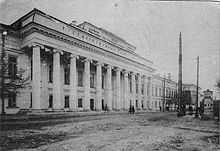
The university soon thereafter became the RSFSR's fifth university to open a 'workers' faculty - a change mandated by a government degree which aimed to provide for the education of peasants. It was thus that on 1 November 1919 peasant workers first took up places, provided to them without the requirement to pass an entrance exam, at the University of Kazan. What is more, in 1922 the university's institute of forestry merged with the agricultural faculty of the Kazan technical university to form the city's Institute of Agriculture and Forestry.
On 29 June 1925 the university was honoured by the presidium of the All-Russian Central Executive Committee, which bestowed the honorific 'V.I Ulyanov-Lenin' on the university as an appendage to its name. This was done it order to recognise the period of time Vladimir Lenin spent as a student at the University of Kazan.
In the 1930s the university continued to evolve, with a number of its faculties being separated from it in order to become independent institutions of higher education. Many of these survive, such as the Kazan State Medical University, survive to this day. Moreover, during the war years 1941-1943, a number of members of the Soviet Academy of Sciences, who had been evacuated from Moscow and Leningrad, were housed in the buildings of the university; this, in turn, led to the foundation of a Kazan department of the academy in 1945.
In the postwar years the University of Kazan underwent a period of rapid expansion and development of its academic base. In recognition of its hard work in providing education to the peoples of the Soviet Union the university was awarded the Order of the Red Banner of Labour in 1953 and later, in 1979, the Order of Lenin. It was also in the 1970s that the university's two distinctive high-rise academic buildings were built - the Department of Physics in 1973 and Faculty of Mathematics in 1978. The final major Soviet-era change to the university came with the opening of a university sports and cultural centre in 1989.
Library
Kazan University Library has one of the world's most important bibliographical collections, including 15,000 manuscripts and 3,000 rare books. Opened in 1809, it first contained Count G. Potemkin's books that were brought to Kazan in 1799 mixed with collections of the earliest bibliophiles V. Polyansky and N. Bulich. Subsequently, the Solovetsky Monastery collections were added to the library.
These original books remain and are kept in the special depository of the library. In this special collection are Arabic manuscripts of philosophers and scholars Mansur Al-Hallaj and Avicenna (11-th century) and Ashshakhrestani (12-th century), a manuscript copy of the Pentateuch, the first Russian printed book "The Apostle" (1564), the "Books of Kingdoms" by Francisco Skorin (1518) and the "Code of Tsar Alexis Mikhailovich" (1649). The Library has first editions of the 18th-century books by Pushkin, Griboyedov, Gogol, Nasíri and Tuqay.
The library contains many 19th century periodicals, and literature about Kazan and the surrounding region. The library boasts itself as "the pride of the University and an invaluable source of information for any researcher." The original library building was built between 1825 and 1833 by Rector N. Lobachevsky, who was at the same time the Chief Librarian of the University. The Library, which now bears his name, is still growing, and even its new building cannot house all the collections. Kazan University also has many museums.
- Buildings of the Kazan State University
-
New academic building of the university and Tatar State Library
-

Physics Institute building
-
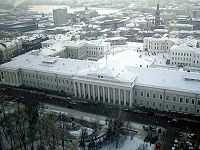
Main campus of the university
-

Chemical Institute
-
Kazan university sport and concert complex
-
Kazan university observatory
Famous faculty and alumni
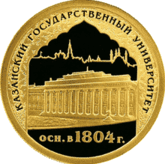
- Aleksandr Arbuzov
- Mily Balakirev
- Sergey Aksakov
- Jan Niecisław Baudouin de Courtenay
- Nikolai Chebotaryov
- Vladimir Bekhterev
- Mikołaj Kruszewski
- Pavel Melnikov-Pechersky
- Velimir Khlebnikov
- Stanislav Govorukhin
- Aleksandr Butlerov
- Vladmir Ulyanov (Vladimir Lenin) (expelled)
- Ilya Ulyanov
- Ivan Yakovlev
- Alexei Rykov
- Xösäyen Yamaşev
- Sergei Bakinsky
- Pyotr Boborykin
- Vladimir Burtsev
- Eugenia Ginzburg
- Naum Meiman
- Kimal Akishev
- Nikolay Motovilov
- Nikolay Lobachevski
- Ivan Simonov
- Vladimir Markovnikov
- Konstantin Mereschkowski
- Leo Tolstoy
- Nikolay Beketov
- Nikolay Zinin
- Peter Lesgaft
- Sergey Malov
- Stepan Smolensky
- Alexander Zaytsev
- Sergey Reformatsky
- Alexander Vishnevsky
- Nikolay Ilminsky
- Liverij Darkshevich
- Daniil Mordovtsev
- Afanasy Shchapov
- Vasili Osipanov
- Alexander Tarasov-Rodionov
- Platon Poretsky
- Nikolai Brashman
- Karl Ernst Claus
- Joseph Johann Littrow
- Christian Martin Frähn
- Johann Bartels
- Karl Fuchs
- Adolph Theodor Kupffer
- Marian Kowalski
- Alexander Kazembek
- Aleksandr Kotelnikov
- Mikhail Lavrentyev
- Yevgeny Zavoisky
- Roald Sagdeev
- Nikolai Semashko
- Vladimir Engelgardt
- Alexander Luria
- Michael Minsky (Spirin)
- Nicolai A. Vasiliev
- Vasily Vasilyev
- Dmitry Karakozov
- Józef Kowalewski
- Yevgeny Zavoisky
- Dmitry Dubyago
- Alexander Dubyago
- Avenir Yakovkin
- Georgii Frederiks
- Nikolay Likhachyov
- Semen Altshuler
- Sergei A. Korolev
- Nikolay Neprimerov
- Vasili Razumovsky
- Mikhail Lyapunov
- Dmitrii Sintsov
- Nikolay Fyodorov
- Oskar Anderson
- Wilhelm Anderson
- Walter Anderson (folklorist)
- Raphael Zon
- Yuliya Zaripova
- Oleg Saitov
- Valentin A. Bazhanov
- Vladimir Galkin
- Kadir Timergazin
See also
- Education in Russia
- List of modern universities in Europe (1801–1945)
- List of Kazan State University's rectors
- List of universities in Russia
References
- ↑ Prime Minister Vladimir Putin signs a series of executive orders granting federal state autonomous university status to several Russian universities
- ↑ Президент подписал Указ «О создании федеральных университетов в Северо-Западном, Приволжском, Уральском и Дальневосточном федеральных округах»
- ↑ Volga Federal University can join KSU, KGFEI, TGGPU and KGASU
- ↑ Распоряжение от 9 апреля 2010 г. №513-р
- ↑ TatCenter.ru. (April 8, 2010) У Казанского (Приволжского) федерального университета новый ректор
- ↑ Regulations of the Kazan State University «Устав государственного образовательного учреждения высшего профессионального образования "Казанский государственный университет им. В.И.Ульянова-Ленина»
- ↑ Lenin.'An Unfinished Autobiography,' 1917. Collected Works, Vol. 41. (Moscow: Progress, 1977.p 430)
External links
| Wikimedia Commons has media related to Kazan University. |
- Kazan (Volga region) Federal University Official site
- Museum of History of Kazan University
- Kazan University Group on LinkedIn
| ||||||||||||||||||||||||||||||
